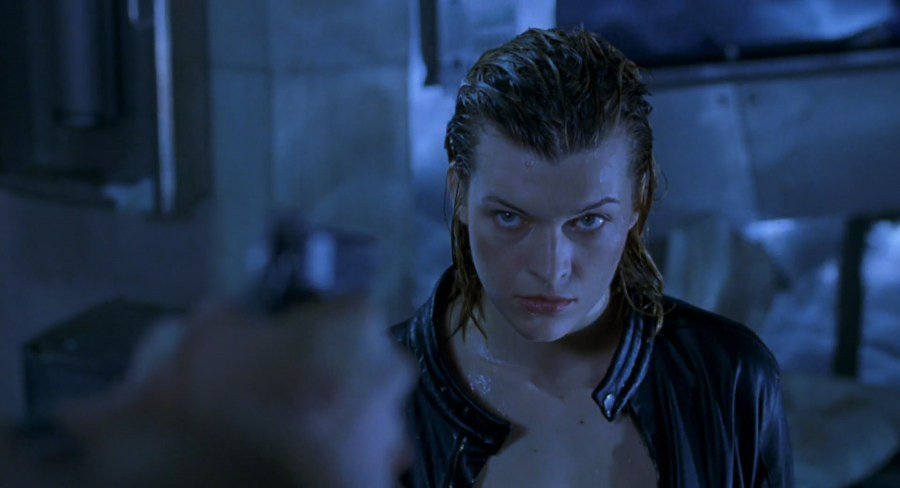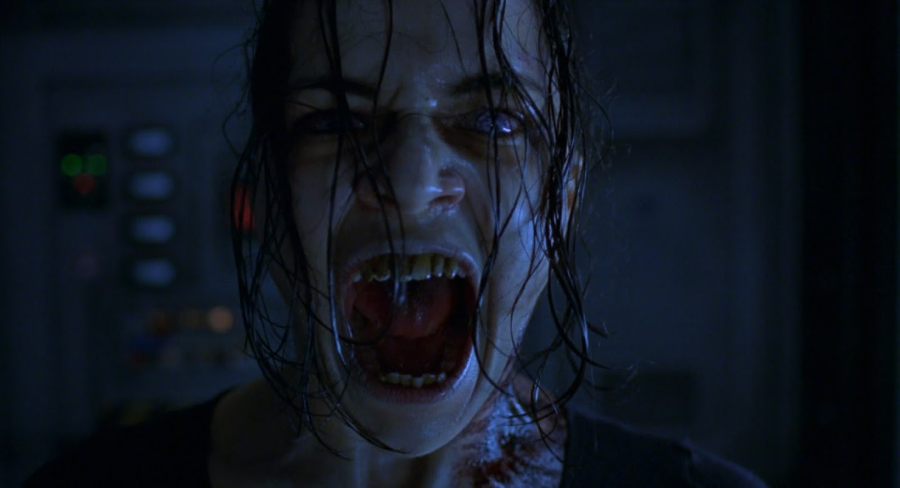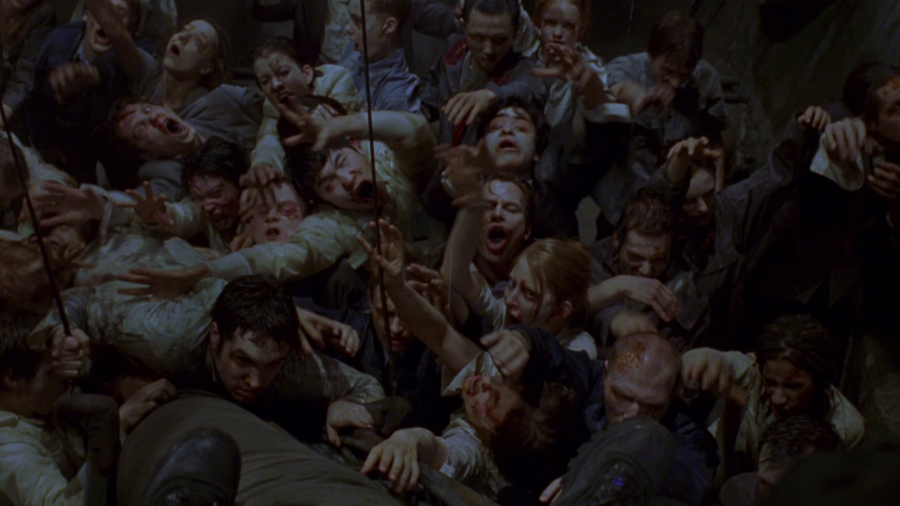RESIDENT EVIL - PART 2
Directed by Paul W.S. Anderson. 2002. United Kingdom/Germany.

V. RESIDENT SUMMARY
RESIDENT EVIL the film opens by spoiling one of the major mysteries of Resident Evil the game. We are told right from the start about the Umbrella Corporation, the largest pharmaceutical company in the United States. Their public-facing image as a simple drug company masks a clandestine enterprise involving bioweaponry and military technologies.
We then see a group of Umbrella employees, none of whom seem particularly menacing or evil, going about their day-to-day in the laboratory. No one in the lab seems to have any clue their employer is engaging in dangerous activities.
Someone enters a laboratory room and snatches up a case of what appears to be a toxin. Right before they exit the room, the unknown person tosses a vial through the air. It shatters on the ground. The thief rushes to the elevator. We can tell from the expressions of the people in the hallways that this person is probably an employee, an inside saboteur who just laid their hands on something very lucrative.
A brief insert shot shows us the point of view of a computerized security system. It notices the shattered vial on the ground. We see a counter beginning to rise as whatever airborne contagion has been unleashed begins to spread, first through the room, then through the air filtration system. What follows is the mass extermination of every man and woman in the labs. The security system releases the brakes on the elevators causing them to crash. Water is poured into several rooms, slowly drowning the people inside. Poisonous gas is released into the air. Panic ensues.
We leave this scene to find our lead, Alice, unconscious and nude in the shower. She gets to her feet, groggy and confused. Wandering through what appears to be a mansion, she discovers a gun in her dresser drawer and a handwritten note. She picks up a pen and scrawls the same message on the paper. It isn’t her handwriting. It’s at this point that we can start to piece two and two together. She is suffering from amnesia, only remembering the brief moments before she collapsed in the shower. Alice doesn’t even recognize the man standing beside her in her wedding photo.
Alice’s brief jaunt through the mansion is interrupted by the arrival of a panicked man. He grabs Alice, trying to push her away from the front door when a team of what appears to be military operatives come crashing through the mansion windows, guns drawn. They wrestle the man to the ground. He says his name is Matt, and that he’s a cop, but a quick search of police staff records fails to turn up his name. The lead operative, One, demands Alice give him a report. Turns out Alice is an Umbrella security agent tasked with guarding the mansion. Her amnesia has been caused by the same security system that killed all those people in the labs below.
This isn’t an ordinary mansion. It’s an emergency entrance to the Hive, a sprawling Umbrella laboratory built beneath the streets of Racoon City, a nondescript town somewhere in middle America. The operatives are an Umbrella task force sent to the labs to find out what triggered the security system to “go homicidal”. They handcuff Matt and together Alice and the team enter a train, descending into the Hive below.
The operatives discover another man, Spence, unconscious in the train car. Alice recognizes him, but only barely. He’s her husband or, as we’re told, part of her cover as an Umbrella agent. Spence is also suffering from amnesia. The team, wisely or not, decides to take him along for the journey.
Once we reach the labs, we learn the mission itinerary. Kaplan, the team’s techie, has a device that will disable the Hive’s security system, an AI construction whose holographic manifestation is modeled on the lead programmer’s young daughter. It is called the Red Queen. Once disabled, the team is to discover the cause of the outbreak. They have a scant two hours to complete this mission. Unfortunately, the Red Queen isn’t keen on being disabled. It kills off four of the operatives, including One, using a laser trap. After disabling its defenses, Kaplan shuts it down but not before the Red Queen can issue one final warning... “you’re all going to die down here”.
With the security system disabled, all the previously locked doors open. What the team doesn’t know is that the contagion that was released was the dreaded T-Virus, a viral agent capable of resurrecting dead tissue. In other words, it’s a zombie virus. It also has other applications. Umbrella has been experimenting on living tissue, injecting it with the T-Virus to see what kind of terrible mutations will occur. One such mutation is freed when the security system goes down, a four-legged beast with a long, razor-sharp tongue.
Our group is soon whittled down to just a handful of survivors. Alice, Matt, Spence, Kaplan, and Rain, a real soldier’s soldier-type who has suffered numerous bites during the zombie carnage. We learn that Matt is a reporter looking to expose Umbrella’s shady business to the public. His sister was working in the labs collecting information during the outbreak. We also learn that Alice was the contact Matt’s sister was working with on the inside. To no one’s surprise, we also learn that Spence was the one who unleashed the T-Virus in the labs, hoping to secure a future for himself on the black market.
Alice remembers that there was an anti-virus in production and with both Rain and Kaplan infected - and their two-hour window rapidly closing - our survivors (sans Spence who has been mauled to death by the aforementioned mutated beast) rush to reach the train before the lab goes on permanent lockdown.
VI. RESIDENT NITPICKING
Right from the get-go, the film starts to fall apart on closer inspection. Why does Umbrella feel the need to post security at the well-hidden secret entrance to the laboratory yet doesn’t post a single guard outside a room housing their super secret and super lucrative superweapon? Why did Umbrella not tell their team of operatives they were heading into a laboratory to investigate the release of an airborne virus? At least, I don’t think Umbrella told them that as the team immediately takes off their gas masks after entering the mansion. Why did Umbrella not tell the team what the T-Virus does, leaving them to be ambushed by zombies? Why was collecting the anti-virus not also a mission imperative? No one seems to even know an anti-virus exists until Alice remembers it in the final 15 minutes of the film.

Moreover, why did Umbrella build an AI-controlled security system meant to deal with viral outbreaks if they were just going to send in a team to turn off said security system immediately following an outbreak? We’re never explicitly told why this team is here except to “investigate”. So Umbrella built a system that can project a holographic, uncannily human interface but forgot to install some kind of offsite uplink that would allow them to access information and security camera footage without making the train trip dozens of miles underground every time they needed to read a Word document?
Why does the Red Queen unleash a neurotoxin that confuses, sedates, and wipes the memory of the people tasked with watching the entrance to the Hive? Wouldn’t you want those people up and ready if something happened below? Why does a laser grid that carves through the flesh of the operatives in the trap room not also carve through their gear, thus destroying the device the team needs to shut down the Red Queen?
So many questions.
But honestly, applying any kind of logic to a movie about walking corpses is self-defeating in the end. I can forgive the movie for some of its plot holes as they barely put a dent in the overall narrative. They’re more like concessions that need to be made for the film to even work. Could they have been handled better? Yes. But this wasn’t a RESIDENT EVIL movie. It was a script made into a RESIDENT EVIL movie.
Paul W.S. Anderson was adamant that his Resident Evil adaptation would not be a simple translation from game to movie screen and he meant it. Virtually everything about the PlayStation game is missing here. We have a mansion, but we only spend about ten minutes there. Chris Redfield, Jill Valentine, Albert Wesker… all of those characters are missing. The classic boss villains are gone, including the iconic Tyrant. We do get one poorly CGI rendered licker, the long-tongued monster from Resident Evil 2, included here probably because of the popularity of the sequel.
There is no Resident Evil to be found here. Even the central, shadowy figure of Umbrella and their motives have shifted. Certainly, Umbrella is a nefarious presence in the script. After all, they created the T-Virus. But our heroes, right down to our lead, are all Umbrella employees. From what we can tell, Umbrella is genuinely concerned with this virus never escaping the lab. So are we rooting for them or against them? Who is the real antagonist in this film?
Even the Red Queen, the “homicidal” AI that wiped out an entire laboratory full of workers… Well, it’s difficult to argue that was a necessarily evil thing to do given the airborne nature of the T-Virus. It was simply doing its job, stopping a potential widespread local - or global - infection. There’s a moment in the film where our survivors are given a choice by the Red Queen. The licker is about to break through a glass panel. The only door leading out of the room is locked by the Red Queen and it refuses to open the door until Alice kills an infected Rain with an ax. Is that harsh? Absolutely. But if Rain is capable of spreading this infection to others…
The moral arguments offered by RESIDENT EVIL are not exactly brought front and center during the film’s running time. They’re more like questions you ponder while sitting and trying to write a review. Because you want to do the film a favor. You want to give it some kind of depth it sorely lacks.
VII. AN ADAPTATION IN NAME ONLY
In the game, the revelation that you were merely a pawn in some bioweapons test felt like a substantial twist. The reveal of Wesker as the true antagonist was a real punch to the gut. Given the fact that we spend no time with either Alice or Spence before the outbreak, they don’t even feel like real characters. They’re blank slates right from the start, their memories wiped, their motivations unclear. When Spence reveals himself as the culprit, Alice barely reacts. Were it not for the utterly useless amnesia angle, maybe this would have come off as some grand betrayal? But we have two characters who don’t remember much, don’t interact more than once or twice on screen, whose lives together might have been meaningful or just playacting (we don’t know)... It bears no weight at all. Spence is a traitor because Wesker was a traitor. It’s an empty nod to a game the movie doesn’t want to resemble on anything but a surface level.

In a way, RESIDENT EVIL feels more like an ALIENS rip-off than an adaptation of the original game. We have a highly skilled team of military guys responding to a crisis only to find themselves knee-deep in combat with a hostile horde, all with a shady corporation lurking in the background. The horror in this horror game adaptation is largely confined to the first act. The opening scenes in the mansion are effectively creepy and well done with great atmospheric lighting and a strong sense of mood. I can imagine what the movie would have been like had it spent more time there. Alice walking the halls, gun in hand as she hears strange moans coming from somewhere in the dark.
But in Anderson’s hands, the film descends rather quickly into gunfire and running through sewer tunnels. Alice’s military training slowly starts to come back to her. In one scene she finds herself cornered by a pack of dogs. In a lazy display of no skill, Anderson has her stand in one place, expertly putting down each charging dog with a single bullet. With only one dog left standing and no more rounds in the chamber, Alice parkours around the room, delivering a slow motion spin kick to the remaining zombified mutt as Marilyn Manson and Marco Beltrami’s soundtrack blares in the background.
If that’s Resident Evil, I’m a refrigerator.
It’s not Resident Evil. It’s RESIDENT EVIL. Horror has taken the backseat, replaced by weak sci-fi and action movie tropes. Not all of those elements are bad. The film has a quick, easy pace to it that never lags or drags. While our non-operative leads are dull as dishwater, the characters of Rain and Kaplan are both lively and engaging. The interplay with the Red Queen was interesting in that it offers up a kind of antagonist with perfectly reasonable yet shockingly horrible motivations for its mass slaughter of innocent people.
But the film gets mired down by its limited scope and terrible screenwriting decisions. Amnesia is fine when it’s used to eventually illuminate some major involvement in a story. But if you’re paying any attention to the film, it becomes very apparent that Spence is the culprit. Only two of the characters are suffering from amnesia, Spence and Alice. Alice is first seen naked in a shower. Spence is found on the train. This isn’t rocket science. You don’t need to be Sherlock Holmes to figure this out.

And in reality, that reveal accomplishes or adds nothing. The survival of the group should have been what’s important here. Why not have them already installed in the labs when the shit goes down? Why not just use the Resident Evil trick of having them be combat guinea pigs? Why give us a group of characters doing the worst possible thing - shutting down a safeguard system preventing mass infection - and a few leads whose personal conflict is kept in the dark until the third act of the film?
RESIDENT EVIL is a poor adaptation of Resident Evil and not just because it tosses out virtually everything about the first game. It misses the mark when it comes to tone, to personality, to flavor. Taken as its own entity, I suppose you can say that it is a standard piece of horror-action filmmaking. Despite its myriad narrative flaws, it isn’t a terrible film. It’s just not substantial in any way. It’s lazy and routine, lacking the kind of immediacy and intrigue that made the first game such a visceral, memorable experience.
The film ends with a now-infected Matt being carted away by Umbrella soldiers. We hear one of them say “I want him in the Nemesis program”. Alice is taken away to a local hospital. When she awakens on a gurney, she finds herself riddled with IVs. Once again waking up unaware of what’s going on, our lead wanders through an empty hospital before walking out into the wrecked streets of a city in the throes of a zombie apocalypse.
The impressive box office returns for Anderson’s film all but guaranteed a sequel. Maybe, I hoped, there would be more Resident Evil in the next RESIDENT EVIL.